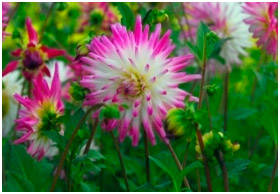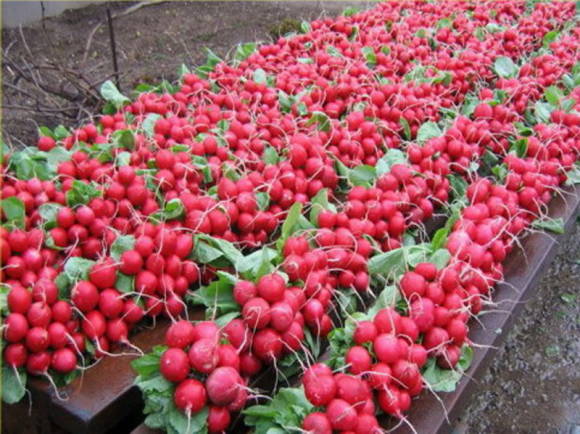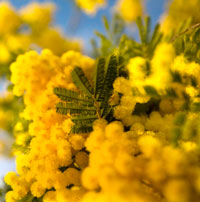 |
At the flower market in Amsterdam, I had the opportunity to purchase seeds of some rare vegetable crops, among them was Mizuna Early with cut leaves. It was immediately clear from the picture on the bag that it was a green salad culture. And the Dutch inscriptions read: Japanese mustard Xiu Cai, Japanese salad Chou. At first I decided to find out in more detail what this culture is in botanical terms.
Mizuna - a variety of Japanese cabbage, which, in turn, belongs to the genus of turnips (Brassica rapa)... It can be found under the name Brassica rapa ssp. japonica, but now it is referred to as another subspecies - Brassica rapa ssp. nipposinica var. laciniata... According to the older classification - Brassica rapa var. lancinifolia... In North America, where it is popular, it is called Mustard Green, Japanese Green Salad.
Mizuna is just one of the varieties of Japanese cabbage. Another - Mibuna(Brassica rapa ssp.nipposinica var.linearifolia) - Mibu Green Salad, Kyoto Green Salad - features whole, long lanceolate leaves.
In Japan, this cabbage has been cultivated since ancient times, it is used to make soups, roast, and is part of the national dish nabemono, like a stew, which is cooked in ceramic dishes. However, the homeland is presumably still China; practically nothing is known about the history of this culture.
Another common Japanese name for them – Kyouna. But we will call it in the future, nevertheless, by the name we have adopted, Japanese cabbage. By the way, her closest relatives within the genus Brassica rapa are considered Peking cabbage (Brassica rapa ssp.pekinensis) and Chinese (Brassica rapa ssp.chinensis).
The culture is very useful, rich in biologically active substances and vitamins, contains a lot of carotene, vitamins C, B1, B2, PP, potassium, calcium, phosphorus, and iron salts. It is indicated after spring vitamin deficiencies, for the prevention of cardiovascular, oncological diseases, with stomach ulcers.
Japanese cabbage varieties
Two varieties of Japanese cabbage are registered in the State Register of Breeding Achievements of the Russian Federation - Little Mermaid ("Gavrish") and Pizhon ("Sedek"). "Aelita" sells seeds of Japanese cabbage variety Mizuna, "Biotekhnika" - varieties with more carved, openwork foliage, which will also serve as a good decoration for dishes - Mizuna Green and Mizuna Red (the latter has an anthocyanin tint of foliage and is most beneficial for the body). And among other things, these varieties are good contenders for an ornamental garden. The culture is cold-resistant, the seeds emerge already at + 3 + 4оС, and the seedlings are able to tolerate frosts down to -4оС. It can be sown in several stages, starting from the end of April, when the soil warmed up to + 10оС, and until the end of August. This season (2013) had its own peculiarities - the cold receded late, the bed was prepared only on May Day, and the sowing fell on May 10. I did not do repeated crops, and I was not mistaken. The outer leaves of all lettuce crops, sown in mid-July, with the onset of prolonged rains, began to rot in late August - early September, and developed slowly due to the cold. So I managed to save half of the mizuna seeds for sowing next year, they retain good germination for 3 years. The seeds of Japanese cabbage are rather small, slightly larger than a poppy seed, and are very similar in appearance to them - grayish-black. My mizune's garden was not very good, with a rather heavy loam, to which I added sand and compost. It is impossible to introduce a lot of organic matter under this crop - it accumulates nitrates in the leaves very well. Sowing was carried out to a depth of 0.5 cm in rows with a distance of about 25-30 cm between them, trying to sow less often. The recommended 10-15 cm between plants did not work out, so the seedlings had to be thinned out a little later, but it turned out to be denser anyway. Under a cover made of non-woven covering material, shoots appeared within a week - typical cotyledonous cruciferous leaves, like radishes. After the emergence of seedlings, I removed the shelter. The optimum temperature for the growth of Japanese cabbage is + 14 + 20 ° C. It took longer to wait for the first opportunity to try greens than green salads - the culture develops slowly (1.5-2 months), especially in the early stages. It is good because the cutting of greens with petioles can be selectively performed earlier, when the leaves reach about 10 cm - a fleshy white taproot remains in the soil and the greens gradually grow back. Mature rosettes (1.5 months) can be cut off completely without affecting the root. To speed up regrowth, I fed her a little twice, with an interval of 2 weeks, with liquid Biohumus (I avoid applying mineral fertilizers for vegetable plants). The foliage has grown again. In addition to weeding, we only needed watering in the heat. The culture turned out to be unpretentious, rather heat-resistant, wilting was observed only with a strong moisture deficit, and after watering it was easily restored. Its good quality is the absence of flowering - out of three sown rows, only 2 specimens bloomed at the end of July, and then modestly, without setting seeds. One drawback of Japanese cabbage was discovered - its leaves are very popular with the cruciferous flea, at some point a lot of perforations appeared on the foliage. It was too late to fight the pest, and it did not damage the taste. The first tasting showed that this is a rather tasty green culture, the leaves, although pubescent, are quite tender, with a slight mustard or rather radish flavor, reminiscent of arugula, but less harsh in taste. Bitterness, like that of mustard leaf, is not felt, there are much less mustard oils in mizuna foliage. Although greens can be cut off, leaving the root, I advise you to pull out by the roots for long-term storage in the refrigerator and store unwashed in a plastic bag. So my mizuna was kept very well for more than a week. This is convenient for summer residents who visit their gardens only on weekends. Japanese cabbage can be consumed fresh, salted, pickled and dry. Recommended for sandwiches, especially with cheese, feta cheese, and most importantly - for any salads - vegetable, meat and fish and even fruit. In salads, it withers pretty quickly, so it is better to use them immediately, although you can finish eating the leftovers the next day. I have used it in pies as a substitute for spinach. Here's a cheese pie recipe, which is usually made with spinach, but mizuna brought in new flavors, making it a little spicier and more interesting. Pie with feta cheese and Japanese cabbage Dough I took puff yeast (purchased), for 2 pies with a diameter of 26-28 cm - 3 packs-rolls. Filling for 2 pies: 2 packs of cheese "Parisian Burenka" (you can Fetaks, who likes pieces), 2 packs of cottage cheese 5% "Lakomo", 300 g each; 2 large bunches of greens of Japanese cabbage (about 300-400 g each); 2 large cloves of garlic, finely grated; some black pepper Recipe: Defrost the dough and place on the bottom of a butter-greased baking dish. For the filling, knead the feta cheese, add the cottage cheese, mix, distribute the grated garlic and black ground pepper. Add greens of Japanese cabbage, chopped in a blender and squeezed from the juice. Stir the filling and spread over 2 cakes. Top the cake with a grid of dough strips.Trim the edges with a rolling pin, use the rest of the dough to decorate the cake. Proof for 40-50 minutes. to a warm place. When the cake comes up, grease it with a beaten egg with a fork, adding 1 tablespoon of water and bake at + 230 ° C in a preheated oven for about half an hour. The pie is good both hot and cold. If someone finds the filling taste too radish, you can mix Japanese cabbage greens with spinach leaves, a little dill, any salads that have grown in your garden. And, of course, such a pie made from homemade yeast, not very rich dough, is even tastier. Here are some more recipes with Japanese cabbage: Salad with ham and mizuna in mustard oil, Rolls with zucchini, avocado and mizuna, Rolls with mizuna and avocado, Salad with mizuna and mushrooms in mustard dressing, Fruit salad with mustard dressing cheese. Photo by the author


Sowing and growing Japanese cabbage

Usage








